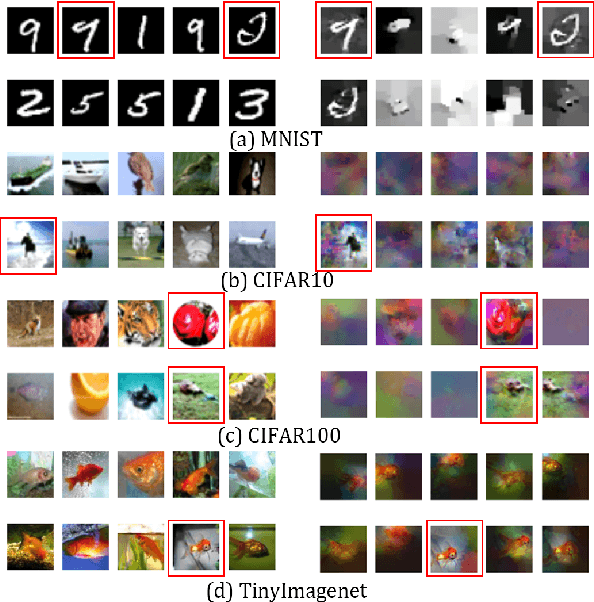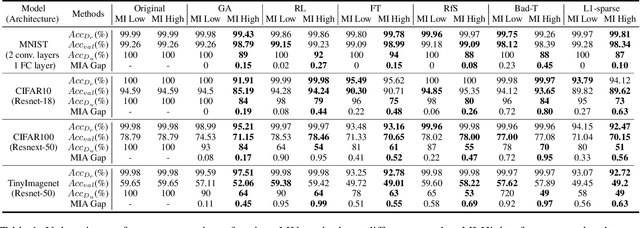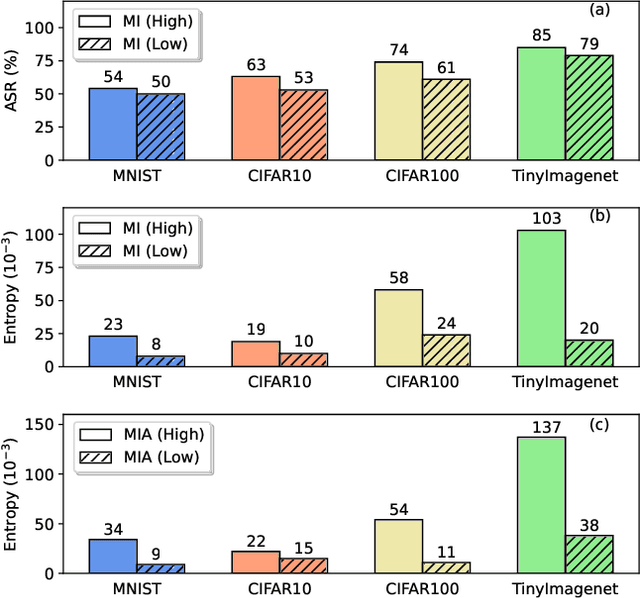Jian Lou
Module-Aware Parameter-Efficient Machine Unlearning on Transformers
Aug 24, 2025Abstract:Transformer has become fundamental to a vast series of pre-trained large models that have achieved remarkable success across diverse applications. Machine unlearning, which focuses on efficiently removing specific data influences to comply with privacy regulations, shows promise in restricting updates to influence-critical parameters. However, existing parameter-efficient unlearning methods are largely devised in a module-oblivious manner, which tends to inaccurately identify these parameters and leads to inferior unlearning performance for Transformers. In this paper, we propose {\tt MAPE-Unlearn}, a module-aware parameter-efficient machine unlearning approach that uses a learnable pair of masks to pinpoint influence-critical parameters in the heads and filters of Transformers. The learning objective of these masks is derived by desiderata of unlearning and optimized through an efficient algorithm featured by a greedy search with a warm start. Extensive experiments on various Transformer models and datasets demonstrate the effectiveness and robustness of {\tt MAPE-Unlearn} for unlearning.
Safeguarding Multimodal Knowledge Copyright in the RAG-as-a-Service Environment
Jun 10, 2025Abstract:As Retrieval-Augmented Generation (RAG) evolves into service-oriented platforms (Rag-as-a-Service) with shared knowledge bases, protecting the copyright of contributed data becomes essential. Existing watermarking methods in RAG focus solely on textual knowledge, leaving image knowledge unprotected. In this work, we propose AQUA, the first watermark framework for image knowledge protection in Multimodal RAG systems. AQUA embeds semantic signals into synthetic images using two complementary methods: acronym-based triggers and spatial relationship cues. These techniques ensure watermark signals survive indirect watermark propagation from image retriever to textual generator, being efficient, effective and imperceptible. Experiments across diverse models and datasets show that AQUA enables robust, stealthy, and reliable copyright tracing, filling a key gap in multimodal RAG protection.
SHAPE : Self-Improved Visual Preference Alignment by Iteratively Generating Holistic Winner
Mar 06, 2025



Abstract:Large Visual Language Models (LVLMs) increasingly rely on preference alignment to ensure reliability, which steers the model behavior via preference fine-tuning on preference data structured as ``image - winner text - loser text'' triplets. However, existing approaches often suffer from limited diversity and high costs associated with human-annotated preference data, hindering LVLMs from fully achieving their intended alignment capabilities. We present \projectname, a self-supervised framework capable of transforming the already abundant supervised text-image pairs into holistic preference triplets for more effective and cheaper LVLM alignment, eliminating the need for human preference annotations. Our approach facilitates LVLMs in progressively enhancing alignment capabilities through iterative self-improvement. The key design rationale is to devise preference triplets where the winner text consistently improves in holisticness and outperforms the loser response in quality, thereby pushing the model to ``strive to the utmost'' of alignment performance through preference fine-tuning. For each given text-image pair, SHAPE introduces multiple visual augmentations and pairs them with a summarized text to serve as the winner response, while designating the original text as the loser response. Experiments across \textbf{12} benchmarks on various model architectures and sizes, including LLaVA and DeepSeek-VL, show that SHAPE achieves significant gains, for example, achieving +11.3\% on MMVet (comprehensive evaluation), +1.4\% on MMBench (general VQA), and +8.0\% on POPE (hallucination robustness) over baselines in 7B models. Notably, qualitative analyses confirm enhanced attention to visual details and better alignment with human preferences for holistic descriptions.
Activation Approximations Can Incur Safety Vulnerabilities Even in Aligned LLMs: Comprehensive Analysis and Defense
Feb 02, 2025



Abstract:Large Language Models (LLMs) have showcased remarkable capabilities across various domains. Accompanying the evolving capabilities and expanding deployment scenarios of LLMs, their deployment challenges escalate due to their sheer scale and the advanced yet complex activation designs prevalent in notable model series, such as Llama, Gemma, and Mistral. These challenges have become particularly pronounced in resource-constrained deployment scenarios, where mitigating inference efficiency bottlenecks is imperative. Among various recent efforts, activation approximation has emerged as a promising avenue for pursuing inference efficiency, sometimes considered indispensable in applications such as private inference. Despite achieving substantial speedups with minimal impact on utility, even appearing sound and practical for real-world deployment, the safety implications of activation approximations remain unclear. In this work, we fill this critical gap in LLM safety by conducting the first systematic safety evaluation of activation approximations. Our safety vetting spans seven sota techniques across three popular categories, revealing consistent safety degradation across ten safety-aligned LLMs.
SecPE: Secure Prompt Ensembling for Private and Robust Large Language Models
Feb 02, 2025Abstract:With the growing popularity of LLMs among the general public users, privacy-preserving and adversarial robustness have become two pressing demands for LLM-based services, which have largely been pursued separately but rarely jointly. In this paper, to the best of our knowledge, we are among the first attempts towards robust and private LLM inference by tightly integrating two disconnected fields: private inference and prompt ensembling. The former protects users' privacy by encrypting inference data transmitted and processed by LLMs, while the latter enhances adversarial robustness by yielding an aggregated output from multiple prompted LLM responses. Although widely recognized as effective individually, private inference for prompt ensembling together entails new challenges that render the naive combination of existing techniques inefficient. To overcome the hurdles, we propose SecPE, which designs efficient fully homomorphic encryption (FHE) counterparts for the core algorithmic building blocks of prompt ensembling. We conduct extensive experiments on 8 tasks to evaluate the accuracy, robustness, and efficiency of SecPE. The results show that SecPE maintains high clean accuracy and offers better robustness at the expense of merely $2.5\%$ efficiency overhead compared to baseline private inference methods, indicating a satisfactory ``accuracy-robustness-efficiency'' tradeoff. For the efficiency of the encrypted Argmax operation that incurs major slowdown for prompt ensembling, SecPE is 35.4x faster than the state-of-the-art peers, which can be of independent interest beyond this work.
MemHunter: Automated and Verifiable Memorization Detection at Dataset-scale in LLMs
Dec 10, 2024Abstract:Large language models (LLMs) have been shown to memorize and reproduce content from their training data, raising significant privacy concerns, especially with web-scale datasets. Existing methods for detecting memorization are largely sample-specific, relying on manually crafted or discretely optimized memory-inducing prompts generated on a per-sample basis, which become impractical for dataset-level detection due to the prohibitive computational cost of iterating over all samples. In real-world scenarios, data owners may need to verify whether a susceptible LLM has memorized their dataset, particularly if the LLM may have collected the data from the web without authorization. To address this, we introduce \textit{MemHunter}, which trains a memory-inducing LLM and employs hypothesis testing to efficiently detect memorization at the dataset level, without requiring sample-specific memory inducing. Experiments on models such as Pythia and Llama-2 demonstrate that \textit{MemHunter} can extract up to 40\% more training data than existing methods under constrained time resources and reduce search time by up to 80\% when integrated as a plug-in. Crucially, \textit{MemHunter} is the first method capable of dataset-level memorization detection, providing an indispensable tool for assessing privacy risks in LLMs that are powered by vast web-sourced datasets.
Machine Unlearning in Forgettability Sequence
Oct 09, 2024



Abstract:Machine unlearning (MU) is becoming a promising paradigm to achieve the "right to be forgotten", where the training trace of any chosen data points could be eliminated, while maintaining the model utility on general testing samples after unlearning. With the advancement of forgetting research, many fundamental open questions remain unanswered: do different samples exhibit varying levels of difficulty in being forgotten? Further, does the sequence in which samples are forgotten, determined by their respective difficulty levels, influence the performance of forgetting algorithms? In this paper, we identify key factor affecting unlearning difficulty and the performance of unlearning algorithms. We find that samples with higher privacy risks are more likely to be unlearning, indicating that the unlearning difficulty varies among different samples which motives a more precise unlearning mode. Built upon this insight, we propose a general unlearning framework, dubbed RSU, which consists of Ranking module and SeqUnlearn module.
Physical Backdoor: Towards Temperature-based Backdoor Attacks in the Physical World
Apr 30, 2024



Abstract:Backdoor attacks have been well-studied in visible light object detection (VLOD) in recent years. However, VLOD can not effectively work in dark and temperature-sensitive scenarios. Instead, thermal infrared object detection (TIOD) is the most accessible and practical in such environments. In this paper, our team is the first to investigate the security vulnerabilities associated with TIOD in the context of backdoor attacks, spanning both the digital and physical realms. We introduce two novel types of backdoor attacks on TIOD, each offering unique capabilities: Object-affecting Attack and Range-affecting Attack. We conduct a comprehensive analysis of key factors influencing trigger design, which include temperature, size, material, and concealment. These factors, especially temperature, significantly impact the efficacy of backdoor attacks on TIOD. A thorough understanding of these factors will serve as a foundation for designing physical triggers and temperature controlling experiments. Our study includes extensive experiments conducted in both digital and physical environments. In the digital realm, we evaluate our approach using benchmark datasets for TIOD, achieving an Attack Success Rate (ASR) of up to 98.21%. In the physical realm, we test our approach in two real-world settings: a traffic intersection and a parking lot, using a thermal infrared camera. Here, we attain an ASR of up to 98.38%.
Clients Collaborate: Flexible Differentially Private Federated Learning with Guaranteed Improvement of Utility-Privacy Trade-off
Feb 10, 2024Abstract:To defend against privacy leakage of user data, differential privacy is widely used in federated learning, but it is not free. The addition of noise randomly disrupts the semantic integrity of the model and this disturbance accumulates with increased communication rounds. In this paper, we introduce a novel federated learning framework with rigorous privacy guarantees, named FedCEO, designed to strike a trade-off between model utility and user privacy by letting clients ''Collaborate with Each Other''. Specifically, we perform efficient tensor low-rank proximal optimization on stacked local model parameters at the server, demonstrating its capability to flexibly truncate high-frequency components in spectral space. This implies that our FedCEO can effectively recover the disrupted semantic information by smoothing the global semantic space for different privacy settings and continuous training processes. Moreover, we improve the SOTA utility-privacy trade-off bound by an order of $\sqrt{d}$, where $d$ is the input dimension. We illustrate our theoretical results with experiments on representative image datasets. It observes significant performance improvements and strict privacy guarantees under different privacy settings.
Cross-silo Federated Learning with Record-level Personalized Differential Privacy
Jan 30, 2024Abstract:Federated learning enhanced by differential privacy has emerged as a popular approach to better safeguard the privacy of client-side data by protecting clients' contributions during the training process. Existing solutions typically assume a uniform privacy budget for all records and provide one-size-fits-all solutions that may not be adequate to meet each record's privacy requirement. In this paper, we explore the uncharted territory of cross-silo FL with record-level personalized differential privacy. We devise a novel framework named rPDP-FL, employing a two-stage hybrid sampling scheme with both client-level sampling and non-uniform record-level sampling to accommodate varying privacy requirements. A critical and non-trivial problem is to select the ideal per-record sampling probability q given the personalized privacy budget {\epsilon}. We introduce a versatile solution named Simulation-CurveFitting, allowing us to uncover a significant insight into the nonlinear correlation between q and {\epsilon} and derive an elegant mathematical model to tackle the problem. Our evaluation demonstrates that our solution can provide significant performance gains over the baselines that do not consider personalized privacy preservation.
 Add to Chrome
Add to Chrome Add to Firefox
Add to Firefox Add to Edge
Add to Edge